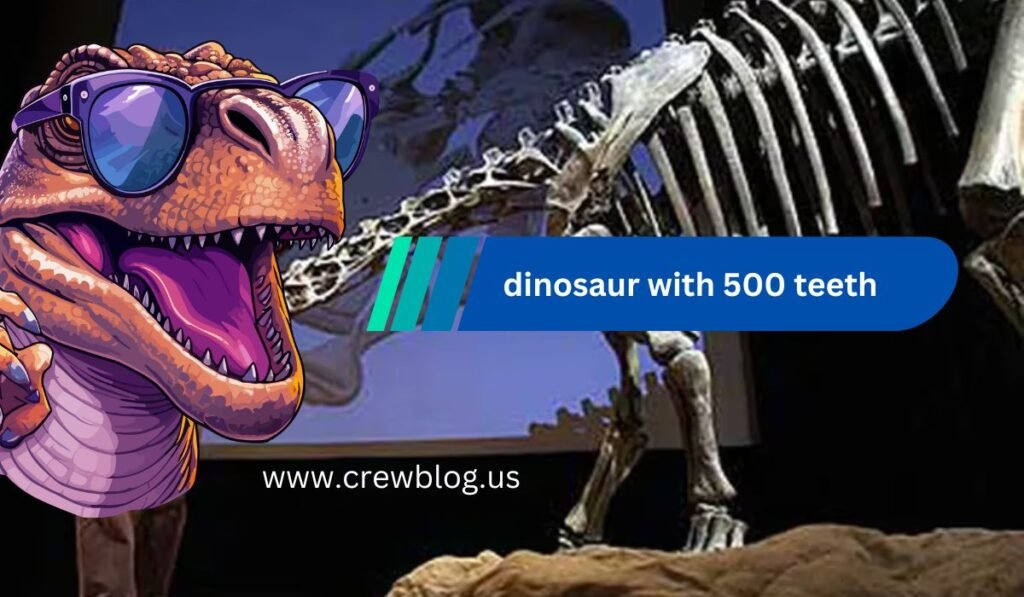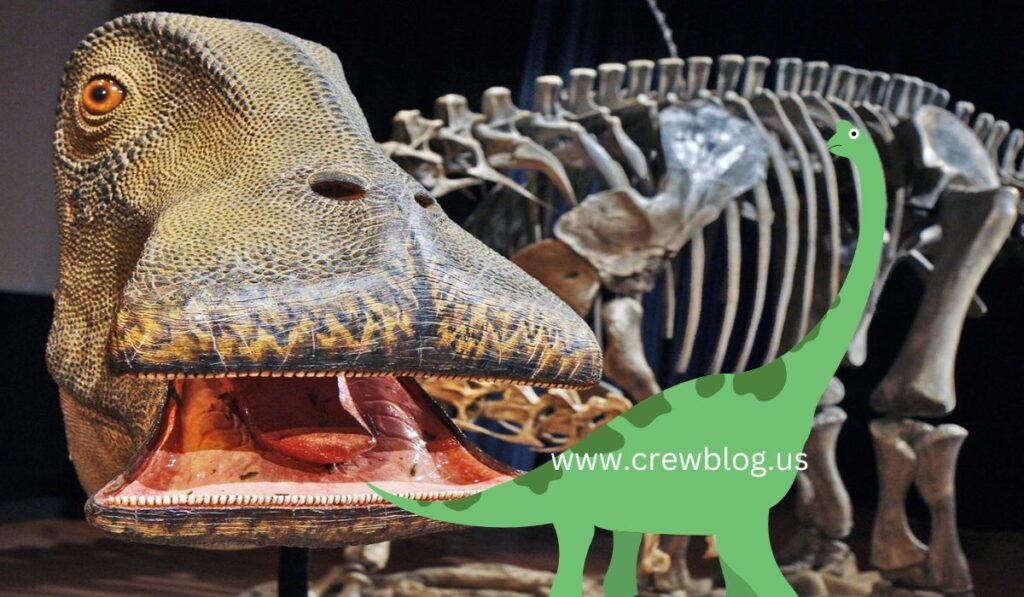Dinosaur with 500 teeth, The big, wonderful world of paleontology has its few darlings, and indeed the fossil of a dinosaur with an astonishing number of teeth does pose an instant ignition in our imagination. Imagine a creature from a distant past that roams the earth, with a mouthful of 500 teeth-5 yardsticks aligned tooth by tooth-serving different purposes in its daily existence. Sounds like fantasy or science fiction, but it is, nonetheless. Nothing short of actual reality in the fantasies of pre-historic or Jurassic Park-like animals. Enter the Nigersaurus, a phenomenal dinosaur that prowled what today known as Niger during the Late Cretaceous period.
The discovery of the dinosaur named Nigersaurus and boasting 500 teeth sent shock waves among the scientist community and other circles of interest. Indeed. This strange dental setting further shrouds the dinosaurs in mystery and gives vital information about their eating habits and their development based on evolution. In this blog. We look in depth at the details of Nigersaurus from anatomy to behavior and why its dental structure is so important. We also provide a closer look at how this dinosaur used its teeth, make comparisons with other dinosaurs. And fill in answers regarding some of our most frequently asked questions about this extraordinary creature.
The Nigersaurus: A Closer Look

Nigersaurus is an interesting dinosaur due to its characteristic traits, especially its impressive dentition. Let’s learn about the important features and significance that made this dinosaur stand out.
Anatomical Features
- Structure of Teeth: Nigersaurus also renowned for the series of some 500 teeth arranged in rows down its jaws. In the case of most dinosaurs, the teeth are conical in shape; this was fairly all-purpose and served several purposes. In the case of Nigersaurus, these teeth were flat, spatula-shaped, designed for cropping vegetation.
- Skull Structure: The skull of Nigersaurus was lightweight and had a wide. Flat snout that probably allowed it to graze on low-lying vegetation. Their dental structure was such that the teeth continually replaced each other throughout their careers. As the teeth would wear down due to its herbivorous diet.
- Size and Build: Nigersaurus was a large dinosaur, weighing about 30 feet in length. It fell under the sauropod category of dinosaurs. All of which characterized by their exceptionally long necks and huge torsos. For its size, however, Nigersaurus was relatively lightweight, further making it capable of grazing efficiently. (Harris et al., 2006)
The Evolutionary Significance of 500 Teeth

This brings up some very interesting questions about the evolution and ecological niche that Nigersaurus had. Let’s explore why this peculiar dental structure emerged and what that said about dinosaur biology.
Evolutionary Adaptations
- Specialized Diet: The numerous flat teeth of Nigersaurus suggestive of its a very specialized diet composed mainly of soft vegetation. The teeth adapted in such a way that large amounts of plant material could processed efficiently. Giving the animal some advantage in its ecosystem.
- Continuous Tooth Replacement: Nigersaurus had a very high rate of tooth replacement. New teeth were replacing the worn-out ones continuously. This adaptation was necessary to keep the feeding mechanism operative and reflects the dinosaur’s dependence on a particular feeding strategy.
- Comparing with Other Dinosaurs: While other sauropods and herbivorous dinosaurs have a lesser number of teeth.Nigersaurus had an abnormally high number. For instance. The famous Brachiosaurus with a few larger teeth that were more for browsing on higher vegetation are contrasted with Nigersaurus that had teeth more suited for grazing. Wilson, 2002.
Unique Dental Anatomy of Various Dinosaurs – Comparative Summary
Meaning that this is better contextualized with other dinosaurs that are known for somewhat peculiar dental arrangements. Such a comparison will provide valuable insights into how different dinosaurs adapted to their ecological niches.
Dental Structures of Selected Dinosaurs
| Dinosaur | Number of Teeth | Dental Type | Dietary Adaptation |
|---|---|---|---|
| Nigersaurus | ~500 | Spatula-shaped | Grazing on low-lying vegetation |
| Brachiosaurus | ~20-30 | Conical | Browsing on high vegetation |
| Triceratops | ~36 | Flattened and robust | Eating tough, fibrous plants |
| Stegosaurus | ~17 | Peg-like | Consuming low-lying vegetation |
Tooth Replacement Rates in Dinosaurs
| Dinosaur | Tooth Replacement Rate | Adaptation |
|---|---|---|
| Nigersaurus | High (continuous) | Efficient processing of vegetation |
| Tyrannosaurus | Moderate | Prey capture and processing |
| Diplodocus | Low | Sustaining large herbivorous diet |
Frequently Asked Questions About Nigersaurus and Its 500 Teeth
What was special about Nigersaurus’ teeth?
Excluding the replacement teeth.Nigersaurus had approximately 500 teeth that were broad, spatula-shaped, and adapted for cropping low-lying vegetation in a manner unique among dinosaurs and reflective of its highly specialized feeding behavior.
To what purpose does Nigersaurus utilize its 500 teeth?
The numerous teeth of Nigersaurus were utilized in clipping and processing huge volumes of plant material. The flat-shaped structure of the teeth was suitably appropriate for grinding and breaking down vegetation.
For what reason would Nigersaurus have this large number of teeth?
This high number of teeth had enabled the effective processing of its plant-based diet by Nigersaurus. The replacement of teeth throughout its lifetime ensured that it maintained effective feeding capability.
How does Nigersaurus compare with other herbivorous dinosaurs?
Unlike other herbivorous dinosaurs that had fewer, larger teeth, Nigersaurus had a high number of smaller teeth. Such adaptations were more relevant to grazing rather than browsing on higher vegetations.
What do the dental structure of Nigersaurus teach us?
The dental structure of Nigersaurus fulfills us with facts regarding its feeding behavior, diet preference, and evolutionary adaptations. The variety of feeding strategies among dinosaurs becomes highlighted.
Conclusion
Dinosaur with 500 teeth The discovery of Nigersaurus, a dinosaur with 500 teeth, opens the window to an amazing adaptation of ancient life. Unique for its teeth structure, it is not only very different from other dinosaurs but also tells much about the feeding strategy and ecological role of dinosaurs in general. Considering the anatomy of Nigersaurus, in comparison with other dinosaurs. Allows us to get a better view of those processes which formed these creatures.
While we continue to learn all of the details about dinosaurs.The case of Nigersaurus reminds us of the great diversity and complication of life that once roamed on our Earth. Understanding such a remarkable creature further raises our appreciation for the complex web of life that existed some millions of years ago and still does wonders in inspiring scientific discovery and curiosity.


